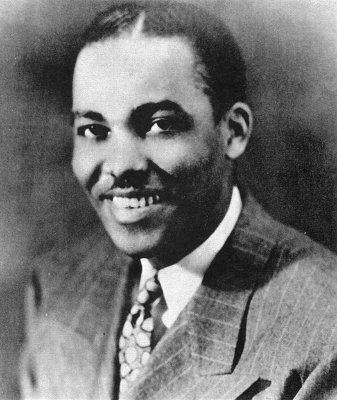Name Joe Garland Role Composer | ||
 | ||
Similar People | ||
In the mood bfjo 2013 joe garland glenn miller
Joseph Copeland "Joe" Garland (August 15, 1903, Norfolk, Virginia – April 21, 1977, Teaneck, New Jersey) was an American jazz saxophonist, composer, and arranger, best known for writing "In the Mood".
Contents
- In the mood bfjo 2013 joe garland glenn miller
- Leap frog joe garland
- In the Mood authorship controversy
- References
Garland studied music at Shaw University and the Aeolian Conservatory. He started by playing classical music but joined a jazz band, Graham Jackson's Seminole Syncopators, in 1924, where he first recorded. He had a long run of associations as a sideman on saxophone and clarinet, with Elmer Snowden (1925), Joe Steele, Henri Saparo, Leon Abbey (including a tour of South America), Charlie Skeete and Jelly Roll Morton in the 1920s. The 1930s saw him playing with Bobby Neal (1931) and the Mills Blue Rhythm Band; he was both a performer and an arranger for the Blue Rhythm Band from 1932 to 1936, when Lucky Millinder replaced him. Following this he played with Edgar Hayes (1937), Don Redman (1938), and Louis Armstrong (1939–42). In the 1940s he played with Claude Hopkins and others, and then returned to Armstrong's band from 1945-47. Following this he played with Herbie Fields, Hopkins again, and Earl Hines (1948). In the 1950s, he went into semi-retirement.
Garland wrote a number of well-known swing jazz hits, including "Serenade To A Savage" for Artie Shaw (one of Shaw's gold records) and "Leap Frog" for bandleader Les Brown.
Leap frog joe garland
"In the Mood" authorship controversy
Garland is credited as the composer (with Andy Razaf as lyricist) of the Glenn Miller hit "In the Mood", but "In The Mood"'s main theme, featuring repeated arpeggios rhythmically displaced, had previously appeared under the title of "Tar Paper Stomp", credited to jazz trumpeter/bandleader Wingy Manone. Manone recorded "Tar Paper Stomp" which did not become popular until the middle of 1930, just months before Horace Henderson used the same tune in "Hot and Anxious," recorded by his brother's band, The Fletcher Henderson Orchestra, on March 19, 1931. Under copyright rules of the day, a tune that had not been written down and registered with the copyright office could be appropriated by any musician with a good ear. A story says that after "In the Mood" became a hit, Manone was paid by Miller and his record company not to contest the copyright.[citation needed] The original recording of Joe Garland's version was made by Edgar Hayes and his Orchestra in 1938, with Garland participating. In this recording there was a baritone sax duet rather than a tenor sax battle. Popular thought is that the melody had already become popular with Harlem bands (e.g. at the Savoy Ballroom) before being written down by Joe Garland. Before offering it to Glenn Miller, Garland sold the tune to Artie Shaw, who could not record it because the original arrangement was too long.[citation needed] The Hayes recording also bears signs of being a shortened arrangement.[citation needed] The tune was finally sold to Glenn Miller, who played around with its arrangement for a while. Although the arrangers of most of the Miller tunes are known, things are a bit uncertain for "In The Mood." It is often thought[by whom?] that Eddie Durham (who contributed other arrangements on the recording date of "In The Mood," Aug. 1, 1939 as well), John Chalmers McGregor (Miller's pianist) and Miller himself contributed most to the final version.
This song was first performed by bandleaders Charlie Barnet and Artie Shaw, but fell out of favor because Garland's original arrangement was too long to fit on one side of a 78rpm record. Garland then brought "In the Mood" to Glenn Miller, who created a shorter arrangement.
